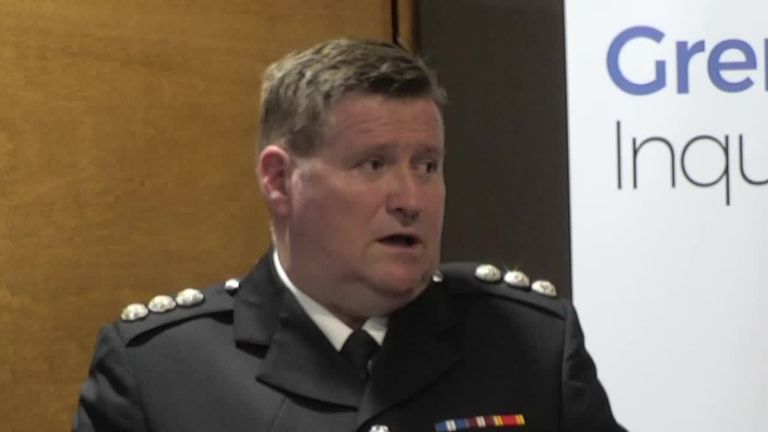Grenfell Tower firefighter pleaded with bosses to abandon 'stay put' policy
Station manager Daniel Egan has told the Grenfell inquiry that he ignored official advice and told people to get out.
Tuesday 3 July 2018 20:49, UK
A senior firefighter who arrived at the Grenfell Tower blaze an hour after it started has said he knew as soon as he arrived they needed to "get people out".
Station manager Daniel Egan told the Grenfell Tower inquiry he had several conversations with more senior staff about the need to change the "stay-put" advice, but did not have the authority to alter it himself.
The senior fire safety officer described how he heard several thuds after arriving in the area of the tower, which according to the official log was just before 2am.
The stay-put advice was not abandoned until 2.47am and firefighters were not able to reach many of the floors until even later.
In his written statement to the inquiry, Mr Egan said he made his way towards the fire, stopping at a car where a firefighter was collating information.
"It was horrendous - I could hear shouting and screaming," he said. "I looked at the firefighters... they seemed to be in awe of what they were seeing, but they knew what they had to do.
"As I was standing by the car bonnet I heard a loud thud - it was right near me. I was told people were jumping from the tower. I knew they weren't going to be alive.
"I could hear that people were so scared and crying for help - I couldn't look. I didn't [wish] to see anyone fall, although I knew it was going to happen. I was thinking 'just get out'."
Inside the tower, firefighters were lined up "like Roman centurions waiting to be deployed" but Mr Egan said he was unable to get any further so went back to the command unit where he passed on the information he had obtained.
It was there that he suggested to the next most senior firefighter on the ground that the "stay-put" advice should be changed, he said.
His written statement continued: "I said the advice was still to 'stay put', but I said we needed to get the residents out... The control room giving the advice couldn't see the fire.
"People can be frightened to step outside of policy but at the end of the day we had to save lives and it was my personal opinion we had to get people out.
"I was not in a position to overrule the stay-put advice but I told GM (group manager) Tom Goodall, the fire survival lead, that I thought we should tell people on the phone to get out if they could."
Mr Egan said the same to group manager Richard Welch - then incident commander - and was told: "We are doing it."
But he said he was informed by others that they "weren't flooding the tower with firefighters".
After a short while, they decided to evacuate the children and disabled occupants, prioritising those below the seventh floor, and he watched as four people were escorted clear from the building.
As he was working to find out which flats were most in need, a firefighter outside the unit had been speaking on a phone to a woman trapped inside.
Mr Egan added: "He said, 'she needs you to get her out'. I said, 'what flat number is she?'... I looked at the board and saw that this already had a P by it, which meant priority. I knew that I had passed on that information ages ago and it had been marked up to show BA (breathing apparatus) sent... But the lady on the phone was still in the flat.
"The crew manager said, 'she just wants to die'. Her boyfriend was 10 yards behind me just staring up at the flat. The woman had said that one of her children was dead and the other was dying. She said she just wanted to die.
"I asked the crew manager, 'can she not get out?' He told me that the phone had gone quiet."
Mr Egan said he went on to speak to another man who he told to get out, regardless of the official advice to stay put coming from the call handlers.
"My view was we should commit crews to every floor - we needed to flood the building with firefighters. I passed my thoughts up the chain of command. It was very frustrating," he said.
By 4.25am, Mr Egan said he realised the firefighters had only reached the 11th floor and that everyone who he had received information about on the floors above had not got out.
Mr Egan, who joined the fire service in 1992, said: "It was a horrible feeling."
In his written testimony, it also emerged the police and some members of the fire service were using different systems to work out which floor was which.
Later, after his statement had been read out, Mr Egan was questioned about why he had asked for the stay-put advice to be abandoned.
"In my opinion, in my experience, through all the years, is that they would have been better off out," he said.
Before Mr Egan gave evidence, a firefighter who arrived first at Grenfell Tower's upper floors, Justin O'Beirne, told the inquiry it should have been "obvious" from the ground that smoke was entering multiple flats.
He wrote in his written statement that a fire hose propping open a stairwell door on the fourth floor of the tower was making conditions in the stairwell "noticeably" worse.








